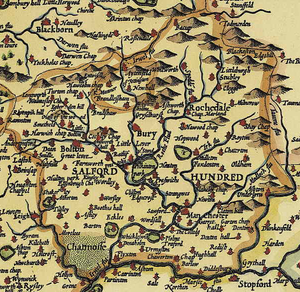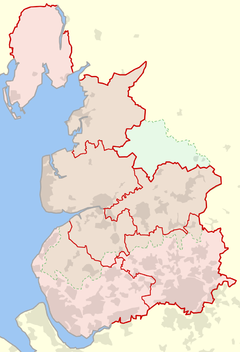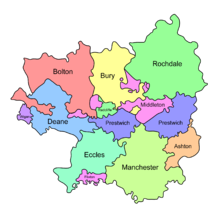- Salford (hundred)
-
Coordinates: 53°33′38″N 2°17′57″W / 53.5606°N 2.2991°W
Salfordshire 
Geography Status Hundred, Royal Manor 1831 area 212,170 acres (859 km²) HQ Salford History Created 11th century Abolished 31 January 1971 Subdivisions Type Parishes Hundreds of Lancashire
The hundred of Salford was an ancient division of the historic county of Lancashire, in Northern England. It was sometimes known as Salfordshire,[1] the name alluding to its judicial centre being the township of Salford (the suffix -shire meaning the territory was appropriated to the prefixed settlement). It is also known as the Royal Manor of Salford[2] and the Salford wapentake.[1][3]
Contents
Origins
The Manor or Hundred of Salford had Anglo-Saxon origins. The Domesday Book recorded that the area was held in 1066 by Edward the Confessor.[4] Salford was recorded as part of the territory of Inter Ripam et Mersam or "Between Ribble and Mersey", and it was included with the information about Cheshire, though it cannot be said clearly to have been part of Cheshire.[5][6][7]
The area became a subdivision of the County Palatine of Lancaster (or Lancashire) on its creation in 1182.
Salford Hundred Court
In spite of its incorporation into Lancashire, Salford Hundred retained a separate jurisdiction for the administration of justice, known as the Court Leet, View of frankpledge, and Court of Record of our Sovereign Lord the King for his Hundred or Wapentake of Salford.[8] Exceptionally for hundred courts, Salford survived until the 19th century.[3] The lordship of Salford passed with the Duchy of Lancaster to the Crown, and a serjeant or bailiff was appointed to administer the hundred on the king's behalf.[4] In 1436 the office of Hereditary Steward of the Wapentake of Salfordshire was granted to Sir Robert Molyneux of Sefton. The office was held by Sir Robert's successors, the Earls of Sefton until 1972.[4]
The Portmote of the Borough of Salford merged with the Hundred Court in the 17th century, and the latter body took over the administrative business of the manorial borough.[8] In 1792 police commissioners were established in Manchester and Salford, and the Hundred Court was left with few powers. By 1828 the activities of the court consisted of the following:[8]
- A twice-yearly meeting of jury-men chose the borough reeve of Salford, along with two constables, a dog-muzzler, ale-taster and inspectors of flesh and fish for the town. The meeting also appointed constables in those townships that did not possess their own court leet. In these townships it also possessed powers to deal with noxious smells and smoke from factories, clearing obstructions of the highway, fencing of roads, foul ditches and enforcement of weights and measures.
- A three-weekly court for the recovery of debts of less than forty shillings. These were held every third Thursday by one of three deputy stewards (usually prominent local solicitors) appointed by the Earl of Sefton.[9]
Reform
 Notice "to the inhabitants of the Hundred of Salford", published by magistrates the day after the Peterloo Massacre
Notice "to the inhabitants of the Hundred of Salford", published by magistrates the day after the Peterloo Massacre
In 1846 the court was reformed to become a Court of Record with its jurisdiction extended to debts not exceeding fifty pounds in value.[9] In 1838 Manchester was incorporated as a municipal borough and granted its own court of record. The two courts were merged as the Salford Hundred Court of Record in 1869 by the Salford Hundred Court of Record Act 1868 (31 & 32 Vict. c. cxxx.). The court had jurisdiction in personal actions only.[9][10] The municipal boroughs of Oldham, Bolton, Heywood and Rochdale successively had their areas exempted from the jurisdiction of the Hundred Court by Order in Council or private Act of Parliament between 1878 and 1893.[8]
In 1910 a committee was appointed by the Chancellor of the Duchy of Lancaster to report on the practices, area and jurisdiction of the court, and whether it was "of benefit to the parties for whose use it was intended". One member of the three-man committee recommended the abolition of the court which had "little but its age to justify its continuance", while the majority called for amending legislation.[11] Accordingly the Salford Hundred Court of Record Act 1911 (1 & 2 Geo. 5 c. clxxii.) was passed to restrict the area of the court to the county court areas of Manchester and Salford and to alter its procedures and costs.[9][12]
Forty years later the court was again referred to a review committee.[13] The committee's report recommended that the court be retained as it provided "a popular and speedy remedy for a large number of litigants in the area".[10] In 1956 the court's area was extended to encompass the entire County Borough of Stockport, which was deemed to belong to the County of Lancashire and the Hundred of Salford for the purposes of assizes, quarter sessions and licensing.[14] The Court of Record for the Hundred of Salford was abolished by section 43(1)(d) of the Courts Act 1971. The last hereditary steward, the seventh Earl of Sefton died on 13 April 1972.[15]
Prisons
Separate places of detention were maintained for the hundred: the New Bailey Prison in Salford, which was replaced by Strangeways Prison in 1868.[9]
Constituent areas
The area it occupied, 212,170 acres (859 km2), corresponds loosely to the modern metropolitan county of Greater Manchester, though excludes those parts from the historic county boundaries of Cheshire, as well as most of that that forms the modern Metropolitan Borough of Wigan. Its area also extended into territory north of what is now Greater Manchester, including parts of Rossendale and Todmorden.
The parish of Manchester formed part of Salfordshire. It has been suggested that a Manchester-shire hundred was not favoured over one centred at Salford because Manchester had been ravaged as part of the Danish occupation.[16]
The parish of Rochdale, in Salfordshire, included the chapelry of Saddleworth from the historic county boundaries of Yorkshire.[3][4]
Parishes and townships
Salfordshire comprised several parishes and townships during its history. These were not static, and changed according to the construction of churches and chapels and increases in population. For example, the township of Hundersfield was one of Rochdale parish's four original townships, but was itself split into four.[1] Similarly, Prestwich-cum-Oldham was later split into two separate parishes of Prestwich and Oldham.
In 1830, Salfordshire was documented to consist of the following parishes and townships:[17]
See also
References
Notes
- ^ a b Hollingworth 1839, p. 10.
- ^ Salford City Council (2004-05-25). "Salford's Local History" (http). salford.gov.uk. http://www.salford.gov.uk/leisure/salfordlocalhistory.htm. Retrieved 2007-11-13.
- ^ a b c "Greater Manchester Gazetteer". Greater Manchester County Record Office. Places names - S. http://www.gmcro.co.uk/Guides/Gazeteer/gazzs.htm. Retrieved 21 February 2008.
- ^ a b c d British History Online. "The Hundred of Salford". Victoria County History. http://www.british-history.ac.uk/report.asp?compid=41403. Retrieved 2007-04-07.
- ^ Harris and Thacker (1987) write on page 252:
Certainly there were links between Cheshire and south Lancashire before 1000, when Wulfric Spot held lands in both territories. Wulfric's estates remained grouped together after his death, when they were left to his brother Aelfhelm, and indeed there still seems to have been some kind of connexion in 1086, when south Lancashire was surveyed together with Cheshire by the Domesday commissioners. Nevertheless, the two territories do seem to have been distinguished from one another in some way and it is not certain that the shire-moot and the reeves referred to in the south Lancashire section of Domesday were the Cheshire ones.
- ^ Phillips and Phillips (2002). pp. 26–31.
- ^ Crosby, A. (1996) writes on page 31:
The Domesday Survey (1086) included south Lancashire with Cheshire for convenience, but the Mersey, the name of which means 'boundary river' is known to have divided the kingdoms of Northumbria and Mercia and there is no doubt that this was the real boundary.
- ^ a b c d Webb, Sidney; Beatrice Webb (1908). English Local Government from the Revolution to the Municipal Corporations Act: The Manor and the Borough, Part One. London: Longman's Green and Company. pp. 52–57
- ^ a b c d e "Prison and Court Records" (PDF). Manchester Library and Archives Service. http://www.manchester.gov.uk/downloads/Prison_and_Court_records.pdf. Retrieved 2008-09-05.
- ^ a b Salford Hundred Court Inquiry, The Times, October 9, 1951, p.8
- ^ Salford Hundred Court. Departmental Committee's Report, The Times, February 17, 1911, p.4
- ^ The Times, August 10, 1991, p.2
- ^ Salford Hundred Court, The Times, October 10, 1950, p.3
- ^ The Criminal Justice Administration Act 1956 (c 34), section 7
- ^ Obituary: The Earl of Sefton, The Times, April 15, 1972, p.16
- ^ "Salford". 1911encyclopedia.org. 1911. http://www.1911encyclopedia.org/Salford. Retrieved 2007-11-11.
- ^ Cooper, Salford: An Illustrated History, p. 8
- ^ The parish of Ashton-under-Lyne - Introduction, manor & boroughs | British History Online
Bibliography
- Hollingworth, Richard (1839). Mancuniensis; Or, an History of the Towne of Manchester, and what is Most Memorable Concerning it. W. Willis
External links
Amounderness | Blackburnshire | Leylandshire | Lonsdale | Salfordshire | West Derby
Categories:- Hundreds of Lancashire
Wikimedia Foundation. 2010.


